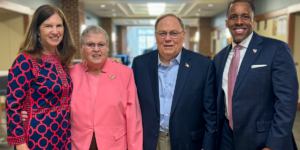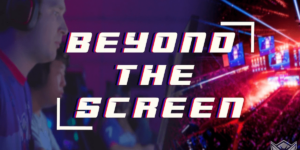It’s not every day that elite branding experts hit the stage at your university to impart their tremendously valuable wisdom. However, that’s what happened April 1 at the Harry F. Byrd, Jr. School of Business’ sold-out Eighth Annual Business Symposium at Halpin-Harrison Hall.
During the symposium’s opening moments, in Stimpson Auditorium, Byrd School of Business Dean Miles Davis, Ph.D., said the school’s “mission is to produce successful, principled leaders with a global perspective. Our keynote speakers embody that mission.”
Those speakers, Patrick Jephson and William Beaman, lead the Washington, D.C., and London-based firm, JephsonBeaman, which handles an array of personal and corporate services, including public relations, protocol and intercultural communication to risk management, crisis planning and security, as well as executive mentoring, presentation coaching and media training, digital marketing and analysis, and editorial services. Their clients range from royal households and Harrods to PBS and Ferrari.
Prior to joining forces, Jephson served as the only chief of staff the late Princess Diana ever had, effectively managing “brand Diana,” while Beaman was a former journalist. As keynote speakers, each discussed about the world of contemporary branding, dovetailing perfectly with the symposium theme, “The New Reality – Meeting The Challenge.”
What is a brand?
Jephson began by defining a brand in very clear terms. “The brand is how other people perceive you. It’s what exists in other people’s minds. It is perception.” A country can have a brand, as can a company or a person, like Princess Diana, whose brand was at its best when she came to America.
Diana understood the power of her brand, Jephson said, and recalled how, during one trip to New York, the princess, dressed in stunningly simple evening attire, utterly charmed a Secret Service agent as she touched his shirt and asked what was there, underneath. When the agent answered that it was a bulletproof vest, she replied with a joke: “Shouldn’t I be wearing that?” In that moment, her brand was clear: she was brave, funny and observant.
Reputation and forgivability
While “brand Diana” had good and bad days, it remained strong for a few key reasons, Jephson said. “She meant, and continues to mean, different things to different people.” Good brands are transferrable like that. She also had forgivability. Forgivability and reputation are closely tied.
Reputation is experience minus expectation, Jephson said. And, it’s very easy to lose. As for forgivability, you need to ask of yourself or or your organization, “When the crisis day dawns, are they going to forgive us?”
He described forgivability through another moment with Diana. It occurred on her last strip to New York City, where she received a Humanitarian of the Year award. She usually gave awards, instead of receiving them, and Jephson didn’t encourage her to take it. However, all turned out well, and when the event was over Jephson said he told Diana that she deserved the honor.
“You’re wrong Patrick,” she responded. “I haven’t earned it. I don’t deserve it. But I’m working on it.” According to Jephson, that’s forgivability. It’s a quality that requires honesty, consistency and morality (not being moralistic or preachy, but having integrity – JephsonBeaman has fired clients when necessary).
A brand needs constant maintenance, too, Jephson said, meaning that employees must embody an entity’s brand. Remember, a company is only as good as its worst employee on his or her worst day. A reputation must be built. “It has to be earned.”
Managing brand and reputation – the “hatchet job” interview
Beaman offered up three vignettes, designed to make attendees think about how quickly brand damage can occur and how to mitigate it.
He talked about an author who continued with a high-profile interview, even as it delved into the author’s past in ways that were not germane to his current work. The story, widely shared online, squelched interest in the author’s second book. The lesson to take from this? In the online era, especially, it’s essential to carefully vet any blogger, publication or broadcast channel for built-in biases, Beaman said. It’s even better to get an email from either an editor or writer about the type of interview planned.
When a problem occurs, it’s time to neutralize, bury and build, by finding material that offsets the problematic material, and instead presents information in the appropriate context. It’s best if the information comes from third parties. The ultimate hope is to push the offensive article off the first page of a Google search and allow brand reputation-building to begin anew.
Managing brand and reputation – power transfer and egotism
In this cautionary tale, Beaman said the firm had a government official client, who kept up with his Twitter feed and responded to a random poster. An exchange of Tweets began that “soon amused the tabloids in New York.” By responding, that Twitter user instantly became an influential journalist. The lesson? “Do not engage,” Beaman said. “Leave your ego at the door. You do not have to respond to everything.”
Managing brand and reputation – social media catastrophe
Then, Beaman looked at a well-documented case not connected to his firm: the firestorm that occurred when it was revealed that Whole Foods’ CEO was a blogger that had long-denigrated a competitor, Wild Oats, on a Whole Foods-sponsored blog. When word got out, it was extraordinarily embarrassing and damaging for Whole Foods, Beaman said, particularly because people assumed the blog criticism’s goal was to push down the price of Wild Oats before Whole Foods moved to purchase it. “Social media alone can shatter reputations,” Beaman said.
Responding to negative press
The urge to “set the record straight,” just pours gasoline on the metaphorical fire, according to Jephson. You can’t really deny negative press or wish it away. However, you can emphasize the positive.
On social media, don’t remove negative comments, unless they’re truly offensive, Beaman said. Otherwise, the move looks like an attempt to stifle genuine conversation. People assess a product through communication with peers and inauthenticity is a cardinal sin. Instead of removing a comment, respond positively, and “put your values out there again.”
The pair’s words resonated throughout the remainder of the symposium, which boasted 500 registrations and a variety breakout sessions focused on current business issues and best practices. Topics ranged from burnout and the lessons learned by recent Byrd School graduates about landing a job, to marketing, human relations challenges, nonprofit fundraising and trends, dressing for success, raising capital and doing more with less.
The symposium’s slate also supported words spoken at the day’s outset by Shenandoah University Vice President of Academic Affairs Adrienne Bloss, Ph.D. – that the school of business serves as lynchpin, because regardless of anyone’s career choice, that career must be financially viable, forward-thinking and entrepreneurial to succeed. Business concerns everyone and every organization, from the federal government to a sole proprietor.




